Article and all photos by Joe Mock, BaseballParks.com
All rights reserved
 |
When the baseball fans of St. Louis, aptly recognized as being the best in America, get used to a name, they don’t like to change it! During Sportsman’s Park’s last 13 years, it was known as Busch Stadium. When the Cardinals moved downtown to a cookie-cutter facility in 1966, it was also called Busch (Memorial) Stadium. Now that the team’s fabulous new park has opened its doors, I guess it should be no surprise that it is called Busch Stadium as well. The fans, as well has Augie Busch himself, wouldn’t have it any other way!
| Ballpark Stats |
 |
| First game: April 10, 2006, a 6-4 win over Milwaukee |
| Capacity: 46,861 (of which, 43,975 are fixed seats or bleachers) once all parts of the park are completed |
| Architect: HOK Sport Venue Event |
| Price: $365 million |
| Home dugout: 1B side |
| Field points: northeast |
| Playing surface: bluegrass |
| Betcha didn’t know: The spot where old Busch Stadium’s right-field foul pole was located is in deep left-center field of the new park |
Some people have already started referring to the new park as “Busch III” to differentiate it from its two predecessors. Not a bad idea. For now, I think I’ll refer to it as “New Busch,” and we’ll call the recently demolished facility “Old Busch.”
So how does the new version measure up? Very well, and as I examine New Busch point by point, I think you’ll see what I mean.
That doesn’t mean that I have no gripes about it. Far from it (and I’ll be laying out those negative aspects throughout the review). But as a successor to the most classic of the downtown “multi-purpose” stadiums built in the 1960s and ’70s, it is most worthy.
As with all of BASEBALLPARKS.COM’s in-depth reviews in recent years, this one will examine New Busch in four key areas: its setting; its exterior; its architectural design and its fan amenities.
The Setting
If you attend games regularly at a certain ballpark, then you develop certain habits — your preferred route to the stadium, favorite place to park, favorite nearby tavern, etc. Now imagine that your team moves into a brand-new ballpark, but you don’t have to change any of your tried-and-true practices.
That’s what has happened for Cardinal fans.
The new Busch Stadium is directly next door to the old Busch Stadium. In fact, there is a spot in deep left field of the new park that would also have been in fair territory near the previous right-field foul pole. Talk about proximity!
This meant that the construction crew had an interesting challenge: how to build as much of New Busch as possible with Old Busch still standing. This is similar to the way Great American Ball Park in Cincinnati was constructed, and in that case, a large chunk of the outfield seating at Cinergy Field was removed prior to the Reds’ final season in the old stadium. There was no such phenomenon in St. Louis, but it did mean that the left-field structure of New Busch wasn’t completed by its opening day.
The good news is that favorable weather and even better planning put that phase of the construction ahead of schedule, and those seats were ready to go about six weeks earlier than originally scheduled.
The setting for New Busch — while not being very different than Old Busch — is still noteworthy. That’s because modern-day architectural thinking no longer creates stadiums in the shape of ash trays, which prevented many of the fans at Old Busch from seeing the city’s prized landmark (the Arch) from their seats. At the new park, it is visible from far more seating sections, including a good portion of the field level. The resulting view, which also includes the city’s beautiful old courthouse, is really something special.
That view will change a little bit in coming years. That’s because the land where the old park once stood will be developed into a “ballpark village,” with shops, commercial space and even some dwelling places. At the time of this writing, it is merely a graded lot.
 |
The aerial shot above helps put the ballpark’s location in perspective. This was taken from a plane preparing to land at the St. Louis airport. It is looking southwest toward the city’s downtown. The Mississippi River is in the foreground, with the gleaming Arch along its banks. New Busch Stadium is close to the center of this scene, as we are looking at the main seating bowl — and its red-red-and-more-red seats — from beyond center field.
By the way, the “flatter” of the two bridges toward the bottom of this shot is the Eads Bridge, and it figures prominently in the design of one of the entryways of the ballpark. More on that later.
But there is one aspect of the setting that is, well, unsettling. The new park is wedged into the land between the old park and a busy, elevated highway. At this point in St. Louis, this highway carries both Interstate 64 and U.S. Highway 40. Now, in my mind, an Interstate would trump a U.S. Highway, and I would assume that locals would refer to this freeway as I-64. They don’t. They all call it Highway 40 — so I will, too.
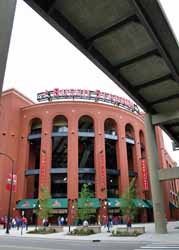  |
The really bad aspect of this is that entryways behind home plate (above left) and near right field are literally in the shadow of this busy highway. I hope that fans will look to the third-base entry as being the “main” entryway into the park, because it is gorgeous, plus its appearance isn’t marred by the freeway. But the fact remains that the home-plate entry and the entire concourse that runs parallel to the first-base line (the exterior of which is shown in the right-hand photo above) are impacted by the view and noise from the elevated highway.
The Exterior
Setting aside the fact that the southern edge of the stadium is so close to Highway 40, the exterior of the new Busch Stadium is absolutely beautiful. The brickwork is wonderful, and in that respect, it reminds me of Ameriquest Field in Arlington.
The entryways are marvelous, although the ones on three corners (behind home plate, left-field and right-field) are pretty similar to each other. By the way, once you’re inside the one behind home, you’ll encounter an awe-inspiring rotunda.
The crowning achievement of the entryways, though, is Gate 3 behind third base. HOK, the architects behind this beautiful ballpark, designed a gateway for the ages, using the Eads Bridge as its inspiration. The shots below let you see what this looks like both outside the stadium and from within.
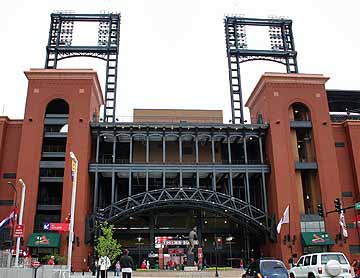  |
When you first arrive at this ballpark, don’t be in a rush to see the inside. Make a point of walking around the exterior to experience all of the nice touches — in the brickwork, in the personalized bricks and “tiles” in the sidewalk, in the landscaping and in the walkway along the north edge of the stadium. This walkway includes not only an unexplained green-and-yellow set of lines crossing the walkway (below left — by the way, it marks where the outfield wall of old Busch Stadium used to be) but also a fence where those without tickets can peer into the place, sometimes even catching a glimpse of action on the field.
  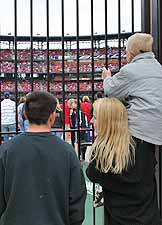 |
The Design
In thinking about the design of New Busch Stadium, I’m reminded what a ballpark-guru friend of mine (Charlie O’Reilly) once said about Turner Field in Atlanta, with all of its arcade space, museum, restaurants galore, etc. He said, “I couldn’t tell if I was in a ballpark or Six Flags Over Georgia!”
That’s how I felt about the Cardinals new home. It seems to me that no idea was omitted from consideration — it’s all here. In fact, the “footprint” of old Busch Stadium occupied about 900,000 square feet. The new park is situated on 1.5 million square feet — and it is all used for shops, kids activities, concessions, music stages — you name it. Truly, New Busch has it all.
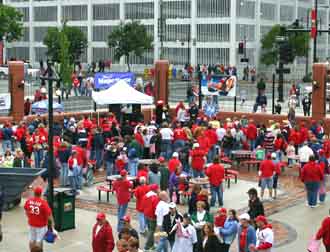 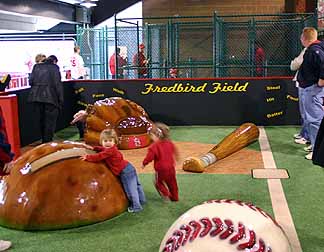 |
Let’s start with the area beyond the outfields. There is the Ford Family Plaza (above left) — not as large or ambitious as the one at Turner Field, but close — where performers entertain the crowd before games. You’ll also find a shop where you can have a baseball bat custom-made for you, and where they also sell autographed memorabilia.
Nearby is the U.S. Cellular Family Pavilion. This features speed-pitch, a batting cage and a play area for toddlers (above right). This Pavilion is under-roof, which is a good thing when it’s a rainy day (like one of the days I spent at new Busch) or the sun is fearsome. The top level of this Pavilion houses the Coca-Cola Scoreboard Patio where for either $80 or $100 (depending on whether it’s a “premium” game or not) you can watch the contest from this elevated perch and eat and drink all you want. This Patio is right next to the Coca Cola Rooftop Deck, which is typically rented out by groups. It is located on top of the batter’s eye in center field, and it features exactly the same menu as the Patio.
Moving around the outfield toward the left-field foul pole, we encounter the Casino Queen Party Porch. It was not completed during my initial visit to new Busch, but one assumes it will cater to high rollers … but personally, I am never in favor of gambling entities as sponsors at baseball facilities.
Once all of the construction is complete, this corner of the stadium will also house the largest of the souvenir stores at the park.
As you continue south on the lower concourse toward the entryway behind home plate, you’ll notice a couple of stretches where the walkway descends a few feet. That’s because the stadium’s plot of ground slopes downward from the outfield toward Highway 40.
Not long after passing the incredible entryway at Gate 3, you encounter the immense rotunda at the home-plate entry (photo below left). It’s worth seeing even if your seats aren’t anywhere near the infield.
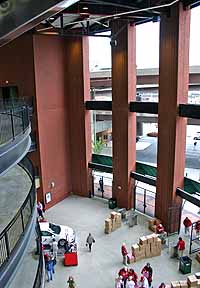  |
When you’re near this area, you’ll notice that the “openings” from this outer concourse (where the concession stands and restrooms are) to the seating bowl is extra large. HOK wasn’t able to make this an “open concourse” (where you can see the field from everywhere on the concourse, like you can at so many modern-day ballparks) in this part of new Busch, but they did provide extra-wide portals so the sights and sounds of the game are never far away.
This also points out that the ballpark was designed with a lot of areas particularly suited to those with “standing room” tickets. In fact, it seemed to me that every walkway and overlook where the field was visible at all was simply jammed with fans who didn’t have a ticket for a real seat. A few days after visiting St. Louis, I attended a game at Dodger Stadium. Even though the game was a complete sell-out, I was struck by how few “standing room” fans there were. It was a stark contrast with New Busch.
Along the concourse that runs parallel to the first-base line you’ll see a clever use of items that ordinarily would’ve been junked (or sold off in pieces) from Old Busch. The scoreboards that hung in the upper deck in the outfield at the old place have been given a new home along these concourses. Their new purpose? To partially block the noise and hustle-bustle of Highway 40, as the freeway runs just a few feet from the exterior of the southern edge of the park. The right-hand photo above shows one of the scoreboards in its new resting place.
As you continue down this concourse, you soon find yourself back at the corner of the structure with the Ford Family Plaza, completing the circuit around the park. Before we go up to the upper levels, let me add that there is something akin to a basement in new Busch — but it is without a doubt the nicest basement you’ve ever encountered!
The Cardinal Club is an extremely exclusive enclave on the ground level of the structure, directly behind home plate. You can enter it from either the rotunda at Gate 2 or from the box seats that are directly behind the backstop. The restaurant/bar area is incredibly opulent, as befits the $230 pricetag per ticket. This ticket lets you sit in these exclusive box seats (below left) and have access to the dining area under the stands (below right). This reminds me of the similar area behind the fancy seats at Philadelphia’s Citizens Bank Park.
  |
The second level up from the main concourse contains only luxury suites. The third level is the Loge, and here certain ticket-holders have access to one of the two “Clubs.” The larger one is called the Redbird Club, and it is truly enormous. Here are numerous food counters, each with different selections, and bars. The smaller one is the Bank of America Club, and its food and drinks are included in the cost of the ticket ($90).
The highest of the four levels is called the Terrace. Its concourse features a souvenir shop and numerous eating choices, including a huge, very visible Hardee’s, which I think is an eyesore. The seats on this level are either boxes, largely below the concourse, or the Terrace Reserved, which are elevated above the concourse (much like the top level of seats at Citizens Bank Park) from about third base all the way around to right field.
The ticket I purchased for one of the games I attended was in the middle of the front row of section 350, which is in the Infield Terrace Box section. This put me directly behind home plate. Great seat, right? Wrong. From my seat, I couldn’t see the pitcher or the batter because, inexplicably, there is a platform for TV cameras there, and a cameraman and his huge camera were directly in front of me.
At many big-league parks, these behind-home-plate cameras are in an area inside the press box devoted just to them. Not here, and this is very annoying.
This leads me to my list of gripes about the design, with the location of this camera platform leading the way. To be fair, some have been addressed, and some are being addressed … but you do wonder why they were incorporated into the design in the first place.
On the Loge level, the angle of the concrete in the seating areas behind home plate causes water to accumulate at the rear of the sections. Adding to the problem is the fact that there isn’t adequate drainage. Now, you might think that this would only be a problem on a rainy day, but you’d be wrong. Because they “power wash” the seating areas after every game to clean them, a lot of water builds up along the areas used by fans to get to their seats. One usher told me that they have to sweep and sweep to try to push this water out of the way prior to every game, but they can never get it all. The solution is to add layers of concrete to these low-lying walkways so the power-wash water will drain away better, but that hadn’t been completed when I was there.
Another design gripe involves the steps that lead you from the Loge concourse down to the seats behind home plate. They are so narrow that only one person can utilize them at a time. This is not efficient at all. Further, the railings at the front of seating sections were blocking the view from a number of seats. It is my understanding that this has already been corrected. Similarly, the foul poles originally erected at new Busch were too wide, and blocked the view of fans seated behind it. They were replaced with thinner poles after just 16 games.
My other main design gripe is the afore-mentioned proximity of the elevated Highway 40 being so very close to the southern edge of the stadium. It would have been nice if there had been another way of laying out the footprint of the park to avoid this. Too late now.
My last gripe involves a combination of design and Cardinal preference. I realize a new stadium needs to provide a never-ending source of revenue for the team, so I don’t mind an abundance of food stands and kiosks selling various concession items and souvenirs. However, I feel my senses are being assaulted when there are free-standing stores at stadiums. At the New Busch, there is the garish Hardee’s on the Terrace concourse — visible from a large percentage of the park — plus two separate U.S. Cellular walk-in stores on the main concourse. I know the architects were just including structures that the Cardinals wanted, but I think this “mall” approach is just too much.